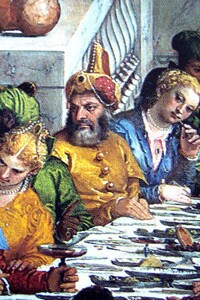The Spectacle of Renaissance Dining

When it came to food, Renaissance Italians weren't that different from us. They too embraced dining as spectacle. In the 15th and 16th centuries, cooks in the Northern Italian courts ambitiously experimented with new and exotic ingredients that explorers brought back from their adventures, while the elite relished in showing off their wealth by showcasing opulent (and sometimes wildly outrageous) dishes at lavish feasts.
This week, art historian and culinary instructor Nancy DeLucia Real will be hosting the course A Renaissance in Dining: Culture and Cuisine of the Northern Italian Courts, held on May 14th and 15th, in conjunction with the exhibition Renaissance Splendors of the Northern Italian Courts at the Getty. She'll be cooking up historical dishes while putting the foods into context with the art of the period.
She imparts some fascinating knowledge about the food history of Northern Italy with us here. For instance, did you know that Leonardo da Vinci, Renaissance Man in every sense, moonlighted as a wedding planner? And much like our beloved kale, tomatoes got its start as garnish at Italian feasts before being incorporated into everyday cooking? Read on for more engaging, historical insights and a Renaissance-era recipe!
What Renaissance Italian foods would be familiar to us today?
Real: At this time, Italians were trendsetters in the art of the banquet and food preparation. At elegant feasts in Northern Italian courts, menus often included: tagliatelle, ravioli filled with chicken, spinach, ricotta, Parmigiano Reggiano; kale, fava bean, or chickpea soups; game meats such as boar; poultry, fried calamari served with lemon slices; frittatas; savory herb and vegetable tortes; apple, pear, or marzipan tarts; pastry cream, candied fruit; and other sweet confections.
What are some of the more unusual dishes they ate that you wouldn't find today in Northern Italy?
Real: By modern-day standards, the most unusual dishes might include dormice, which are rodents, cranes, and herons. However, pies containing live birds and golden platters staging colorful peacocks seem to stand out. One 15th-century chef, Maestro Martino of Como, instructs other cooks on how to present a peacock "with all its feathers, so that when cooked, it appears to be alive and spews fire from its beak." Eventually, the bird was replaced by the exotic turkey from the New World.
Were there unusual dining practices in the court? And are any of those practices still used today?
Real: A Renaissance courtier carried his or her own golden toothpick in a gem-studded, golden case -- a true status symbol! It hung around the neck to facilitate cleaning one's teeth in public. I was shocked when I discovered this because it
contrasted with my upbringing in Italy.

Table manners were important in the Renaissance. You may recognize some of them -- licking one's fingers while eating was considered rude. Blowing one's nose in the tablecloth and making gulping noises while drinking were unacceptable. A diner was not to yawn or look bored while listening to his or her dinner companion's conversation. And besides rules of behavior, we inherited the fork from Renaissance.
European explorers were discovering the New World at this time. What foods did Northern Italians particularly embrace?
Real: When Columbus arrived in America in 1492, he encountered many varieties of beans (among other foodstuffs). The haricot bean, also known as the navy bean, was introduced to Italy between 1528 and 1532 and was cultivated in the Veneto and Tuscan regions. Corn arrived in Italy from Mesoamerica in the sixteenth century. Previously, porridges, including polenta, had been made with millet, chickpea flour, spelt, and faro. Now corn became a common staple in food fare for peasants.
What was brought back but rejected or considered too exotic for the Italian palate?
Real: Tomatoes arrived from America in the sixteenth century. They were used as table decorations. In fact, the tomato was called "pomo d'oro" or "the golden apple" by Italians. It wasn't until the late eighteenth century that tomatoes became part of Italian cuisine.
Paintings of Renaissance feasts look kind of chaotic and rather debauched. Are those paintings accurate?
Real: Remember that, like the birds flying out of a pie, many forms of entertainment happened simultaneously. In 1490, Ludovico Sforza, Duke of Milan, appointed Leonardo da Vinci as the wedding planner for his nephew's wedding. Leonardo turned the courtyard of the palace into a fairyland jungle. Many servants were dressed as wild beasts. Other servants appeared dressed as birds flying through the air on an intricate series of invisible wires devised by the master artist -- I think Leo was like today's wedding planner. While between courses at the wedding feast, he arranged for fantastically-dressed tumblers, fire-eaters, little people, and belly dancers to parade across the table.
Need more chaos? After the meal, Leonardo contrived the planets spinning through the sky, a 20-foot high waterfall pouring out of the sky and an elephant disappearing into thin air.
What's the most surprising discovery for you about Renaissance eating?
Real: Regarding traditional Italian cuisine as we know it today, all ingredients must be balanced. This means that one ingredient should not overpower another.
However, in Renaissance Italy, cooks used exotic and costly spices rather heavily, since they spoke of the host's wealth. Black pepper, cardamom, cinnamon, cloves, ginger, mace, nutmeg, saffron, and sugar were customarily added to savory dishes (not necessarily combined in this order). Tagliatelle noodles were served with butter, sage, sugar, cinnamon, and hazelnuts. I was pleasantly surprised to discover the presence of spices, sugar, and rosewater in rice and pasta dishes.
Since the concept of "dessert" did not yet exist, Renaissance cooks balanced the flavors of their dishes by serving sweet and savory foods alongside each other at every course. Now, how cool is that?



